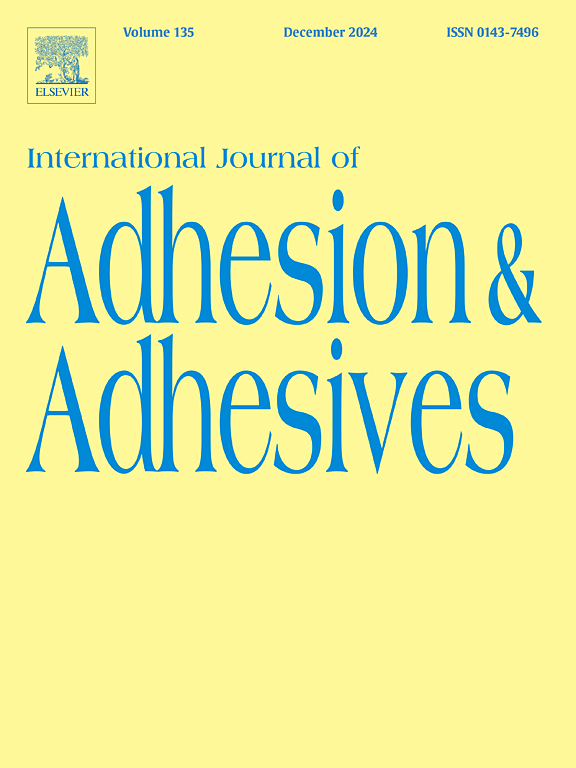Effectiveness of olive mill wastewater treatment in enhancing physicochemical properties of resin surfaces against bacterial adhesion
IF 3.5
3区 材料科学
Q2 ENGINEERING, CHEMICAL
International Journal of Adhesion and Adhesives
Pub Date : 2025-09-28
DOI:10.1016/j.ijadhadh.2025.104169
引用次数: 0
Abstract
Resins are widely used as adhesives for coatings due to their mechanical, adhesive and strength properties. However, these polymers still have limited performance against bacterial adhesion, which poses a critical problem for healthcare facilities. Preventive strategies have therefore been developed to improve the antiadhesive activity of resin coating surfaces against bacterial adhesion. In this study, we evaluated the effectiveness of treating epoxy, acrylic and nitrocellulose resin surfaces with olive mill wastewater (OMW) to improve their surface properties against the adhesion of Staphylococcus aureus and Pseudomonas aeruginosa. The contact angle results showed that the relatively hydrophobic epoxy (θw = 71.4 ± 0.5°), acrylic (θw = 78.5 ± 1.8°) and nitrocellulose (θw = 87.4 ± 2.2°) were turned into relatively hydrophilic with increased electron donor (γ–) character after OMW treatment, thus improving its physicochemical properties. In addition, the bacterial adhesion results showed that epoxy, acrylic and nitrocellulose surfaces treated with OMW had a significant anti-adhesion activity against S. aureus and P. aeruginosa adhesion, compared with untreated surfaces, as well as a good correlation was observed between the wettability and electron donor properties of resin surfaces and the bacterial coverage rate. These results provide insights into the development of effective, eco-friendly, and anti-adhesive resin surfaces against bacterial adhesion.
橄榄厂废水处理对提高树脂表面抗细菌粘附的理化性能的效果
树脂由于其机械性能、粘接性能和强度性能而被广泛用作涂料的粘合剂。然而,这些聚合物对细菌粘附的性能仍然有限,这对医疗机构构成了一个关键问题。因此,预防策略已被开发,以提高树脂涂层表面抗细菌粘附的抗粘附活性。在这项研究中,我们评估了用橄榄厂废水(OMW)处理环氧树脂、丙烯酸树脂和硝化纤维树脂表面对金黄色葡萄球菌和铜绿假单胞菌的粘附性能的改善。接触角结果表明,相对疏水的环氧树脂(θw = 71.4±0.5°)、丙烯酸(θw = 78.5±1.8°)和硝化纤维(θw = 87.4±2.2°)经OMW处理后,相对疏水的环氧树脂(θw = 71.4±0.5°)转变为相对亲水的树脂,电子给体(γ -)特性增强,从而改善了其理化性能。此外,细菌粘附结果表明,与未经处理的表面相比,经OMW处理的环氧树脂、丙烯酸树脂和硝化纤维素表面对金黄色葡萄球菌和铜绿假单胞菌的粘附具有显著的抗粘附活性,并且树脂表面的润湿性和电子供体性质与细菌覆盖率之间存在良好的相关性。这些结果为开发有效的、环保的、抗细菌粘附的树脂表面提供了见解。
本文章由计算机程序翻译,如有差异,请以英文原文为准。
求助全文
约1分钟内获得全文
求助全文
来源期刊

International Journal of Adhesion and Adhesives
工程技术-材料科学:综合
CiteScore
6.90
自引率
8.80%
发文量
200
审稿时长
8.3 months
期刊介绍:
The International Journal of Adhesion and Adhesives draws together the many aspects of the science and technology of adhesive materials, from fundamental research and development work to industrial applications. Subject areas covered include: interfacial interactions, surface chemistry, methods of testing, accumulation of test data on physical and mechanical properties, environmental effects, new adhesive materials, sealants, design of bonded joints, and manufacturing technology.
 求助内容:
求助内容: 应助结果提醒方式:
应助结果提醒方式:


